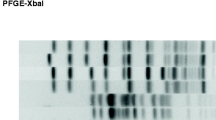Abstract
Stool samples of 616 asymptomatic and 296 diarrhoeic school children were compared for the recovery rate ofAeromonas spp. on ampicillin (10 µg/ml) sheep blood agar. Culture filtrates of isolates were tested for heat-stable enterotoxin by the infant mouse test and haemolysin production with 1% freshly washed rabbit erythrocytes. Stools of 9 (3.0%) diarrhoeic children yielded five strains ofA. hydrophila and four ofA. veronii (two each of biotypessobria andveronii), compared to 12 (1.9%) (p>0.01) asymptomatic children who harbored sevenA. hydrophila and fiveA. caviae strains. Isolates from-diarrhoeic stools were exclusively from children ⩽5 years, while all infected asymptomatic children were ⩾6 years. Culture filtrates of all nine diarrhoeic strains were uniformly enterotoxigenic (intestinal weight ratio >0.083) and produced haemolysin titres >128. These phenotypes where variable in carriage strains ofA. hydrophila but were not detected inA. caviae. The recovery ofA. hydrophila, andA. veronii biotypes from diarrhoeic stools of children ⩽5 years may suggest their involvement in diarrhoea causation in the absence of other diarrhoeagenic agents.
Similar content being viewed by others
References
von Graevenitz A, Altwegg M.Aeromonas andPlesiomonas. In: Barlows A, Hausler Jr WJ, Herrmann KL, Isenberg HD, Shadomy HJ, eds. Manual of clinical microbiology. Washington, DC: American Society for Microbiology, 1991: 396.
Janda JM, Duffey PS. Mesophilic aeromonads in human disease: current taxonomy, laboratory identification, and infectious disease spectrum. Rev Infect Dis 1988; 10: 980–997.
Altwegg M, Steigerwalt AG, Altweeg-Bissig R, Luthy-Hottenstein J, Brenner DJ. Biochemical identification ofAeromonas genospecies isolated from humans. J Clin Microbiol 1990; 28: 258–264.
Colwell RR, MacDonell MT, DeLey J. Proposal to recognize the familyAeromonadaceae fam. nov. Int J Syst Bacteriol 1986; 36: 473–477.
Altwegg M, Geiss HK.Aeromonas as a human pathogen. Crit Rev Microbiol 1989; 16: 253–286.
Turnbull PCB, Le JV, Miliotis MD, et al. Enterotoxin production in relation to taxonomic grouping and source of isolation ofAeromonas species. J Clin Microbiol 1984; 19: 175–180.
Eko FO, Utsalo SJ. Comparative study of the prevalence and clinical profiles of diarrheas due toAeromonas and other enteric pathogens. J Hyg Epidemol Microbiol Immunol 1990; 34: 183–189.
Utsalo SJ, Eko FO, Antia-Obong OE. Features of cholera andVibrio parahaemolyticus diarrhoea endemicity in Calabar, Nigeria. Eur J Epidemiol 1992; 10: 175–180.
Popoff M. Genus, III:Aeromonas. Kluyver and van Niel 1936, 398, In: Krieg NR, Holt JG, eds. Bergey's manual of determinative bacteriology. Baltimore, The Williams & Wilkins Co, 1984: 545.
Janda JM. Recent advances in the study of the taxonomy, pathogenicity, and infectious syndromes associated with the genusAeromonas. Clin Microbiol Rev 1991; 4: 397–410.
Carnahan AM. Update on current identification methods for clinicalAeromonas isolates. Med Microbiol Lett 1993; 2: 212–216.
McFaddin JF, ed. Biochemical tests for the identification of medical bacteria, 2nd ed. Baltimore: The Williams & Wilkins Co, 1980.
Eko FO, Utsalo SJ. Characterization and significance ofAeromonas spp. isolated from diarrhoeic stools in Nigeria. J Trop Med Hyg 1989; 92: 97–101.
Namdari H, Bottone EJ. Microbiological and clinical evidence supporting the role ofAeromonas caviae as a pediatric enteric pathogen. J Clin Microbiol 1990; 28: 837–840.
Goodwin CS, Harper WES, Stewart JK, Gracey M, Burke V, Robinson J. EnterotoxigenicAeromonas caviae as a pediatric enteric pathogen. J Clin Microbiol 1990; 29: 837–840.
Doedhar LP, Saraswathi K, Varudkar.Aeromonas spp. and their association with human diarrheal disease. J Clin Microbiol 1991; 29: 853–856.
Mikhail IA, Fox E, Haberberger RL, Ahmed MH, Abbattee EA. Epidemiology of bacterial pathogens associated with infectious diarrhea in Djibouti. J Clin Microbiol 1990; 28: 956–961.
Pitarangsi C, Echeverria P, Whitmire R, et al. Entropathogenicity ofAeromonas hydrophila and Plesiomonas shigelloides: prevalence among individuals with and without diarrhoea in Thailand. Infect Immun 1982; 35: 666–673.
Pazzaglia G, Sack RB, Salazar E, et al. High frequency of co-infecting enteropathogens in Aeromonas-associated diarrhea of hospitalized Peruvian infants. J Clin Microbiol 1991; 39: 1151–1156.
Altwegg M, Johl M. Isolation frequencies ofAeromonas species in relation to patient age. Eur J Clin Microbiol 1987; 6: 55–56.
Challepalli M, Tess BR, Curningham DC, Chopra AK, Houston CW. Amwnonas-associated diarrhea in children. Pediatr Infect Dis J 1988; 7: 693–698.
San Joaquin VH, Pickett DA.Aeromonas-associated gastroenteritis in children. Pediatr Infect Dis J 1988; 7: 53–57.
Sack DA, Chowdhury KA, Hug A, Kay BA, Sayeed S. Epidemiology ofAeromonas and Plesiomonas diarrhoea. J Diarrhoeal Dis Res 1988; 6: 107–112.
Janda JM, Reitano M, Bottone EJ. Biotyping ofAeromonas isolates as a correlate to delineating a species-associated disease spectrum. J Clin Microbiol 1984; 19: 44–47.
Nmdari H, Bottone EJ. Cytotoxin and enterotoxin production as factors delineating entropathogenicity ofAeromonas caviae. J Clin Microbiol 1990; 28: 1796–1798.
Burke V, Gracey M, Robinson J, Peck D, Beaman J, Cundell C. The microbiology of childhood gastroenteritis:Aeromonas species and other infective agents. J Infect Dis 1983; 148: 68–74.
Author information
Authors and Affiliations
Rights and permissions
About this article
Cite this article
Utsalo, S.J., Eko, F.O., Antia-Obong, O.E. et al. Aeromonads in acute diarrhoea and asymptomatic infections in Nigerian children. Eur J Epidemiol 11, 171–175 (1995). https://doi.org/10.1007/BF01719483
Accepted:
Issue Date:
DOI: https://doi.org/10.1007/BF01719483




